Construction and Demolition Waste Management Research: A Science Mapping Analysis
Abstract
:1. Introduction
2. Methodology
2.1. Bibliometric Search
2.2. Scientometric Analysis
2.3. Qualitative Analysis
3. Results and Findings
3.1. Results of Scientometric Analysis
3.1.1. Number of Publications
3.1.2. Sources of Publications
3.1.3. Co-Authorship Analysis
3.1.4. Citations of Publications
3.1.5. Active Countries
3.1.6. Co-Citations of References
3.1.7. Co-Occurrence of Keywords
3.2. Findings of Qualitative Assessment
3.2.1. Waste Quantification
3.2.2. Analysis Methods of Waste Management
3.2.3. Environmental Impacts of Waste
3.2.4. Performance and Behavior of Waste
3.2.5. Waste Management Plan
3.2.6. Waste Diversion Practices
3.2.7. Emerging Technologies in Waste Management
4. Research Gaps and Future Research Directions
- 1.
- Understanding the environmental consequences of CDW is still inadequate, and few control measures for these pollutants have been developed [117]. As a result, future directions could include: (1) attempting to comprehend the complexity of pollutants in CDW, (2) developing additional tests and methodologies to assess environmental repercussions caused by CDW, and (3) developing comprehensive control measures for CDW treatment and disposal.
- 2.
- There have been some widely adopted management programs or incentive policies (e.g., landfilling charging rate) that aim at promoting CDW diversion. However, the effectiveness of these programs or policies has not been widely investigated [118]. Therefore, more thorough performance measurement mechanisms for CDW management, as well as a proper CDW management guide tailored to a certain local environment, are needed.
- 3.
- Closed loop of CDW materials should be further investigated in the context of a circular economy. This implies that waste materials shall be reused and recycled as resources in other life cycles, rather than being disposed of in landfills [119]. The reverse logistics network with uncertainties in multiple parameters (e.g., quality of recycled products, recycling rate and cost, and demand and supply rates) or objectives (i.e., social, environmental, and economic benefits) will also be a significant direction in regional CDW management.
- 4.
- There has been an insufficient focus on social sustainability when evaluating CDW treatment techniques, with a focus dedicated to the economic and environmental aspects of recycling CDW [120]. As a result, future research should focus on developing a technique that incorporates a framework, indicators, categories, and assessment indices for evaluating social sustainability. Furthermore, more studies are needed to perform comprehensive economic, social, and environmental assessments of CDW diversion practices.
- 5.
- Developing countries may encounter difficulties when they strive to learn from the adopted CDW treatment methods in developed countries. There has not been enough research to bridge the gap between developing and developed nations yet [121]. In this context, comparing the economic, social, and managerial aspects of CDW diversion practices would benefit the global research and practice community in determining appropriate CDW management plans in a particular country.
- 6.
- There is a research gap in the use of material flow analysis for mixed waste, which comprises many components with varying life periods and distributions, making data collection and analysis more complicated. Therefore, extending the combination of numerous data collecting sources, methodologies, and data processing techniques to research many materials is advisable. Additionally, it is recommended to conduct more research on assessing the environmental and economic implications of materials stocks and flows in the long term [122].
- 7.
- For LCA applications, the existing literature focuses on specific cities without tracing the primary source of materials. A thorough LCA should evaluate the socioeconomic conditions of the countries where raw materials are collected and processed until being delivered as construction materials or products. When selecting the best end-of-life option for CDW, the same considerations should be taken into account [123].
- 8.
- For the emerging technologies, future research can expand the application of geographic information systems (GIS) to identify CDW illegal dumping areas, BIM to estimate waste quantities, ensure waste management cooperation among stakeholders, and analyze waste throughout the building life cycle, big data to study the CDW practice, and prefabricated construction to reduce the generated waste [124,125,126,127]. There is also a need to incorporate Industry 4.0 and new data-driven methodologies (e.g., digital twin and artificial intelligence) to enhance decision-making in CDW management [123].
- 9.
- Most recent research has focused on waste disposal and treatment, with little effort made to avoid the formation of CDW from an early design stage [128]. The CDW generation is affected by multiple factors, such as stakeholder attitudes and behavior as well as economic incentives [129]. However, limited studies have been undertaken to examine the influence of employing economic incentives/penalties (e.g., disposal charging system) to minimize waste generation.
- 10.
- Human aspects shall be investigated in relation to the CDW management program [110]. There has been little research to date that examines the influence of multiple stakeholders’ involvement in CDW management. Therefore, further studies are required to understand ways to foster multi-sectoral engagement and collaborative governance [130,131]. The focus shall be also given to the possibility of changing practitioners’ attitudes through a management program or incentive policy as indicated by Yuan and Shen [132].
5. Discussion
6. Conclusions
Supplementary Materials
Author Contributions
Funding
Data Availability Statement
Conflicts of Interest
References
- Shen, L.Y.; Tam, V.W.; Tam, C.M.; Drew, D. Mapping approach for examining waste management on construction sites. J. Constr. Eng. Manag. 2004, 130, 472–481. [Google Scholar] [CrossRef] [Green Version]
- Tchobanoglous, G.; Theisen, H.; Eliassen, R. Solid Wastes: Engineering Principles and Management Issues; McGraw-Hill Book Company: New York, NY, USA, 1977. [Google Scholar]
- EPA (Environmental Protection Agency). Characterization of Building-Related Construction and Demolition Debris in the United States. 1998. Available online: https://www.epa.gov/sites/production/files/2016-03/documents/charact_bulding_related_cd.pdf (accessed on 16 March 2022).
- Attia, T.; Elshaboury, N.; Hesham, A.; Elhadary, M. Quantifying Construction and Demolition Waste Using Slam-Based Mobile Mapping System: A Case Study from Kafr El Sheikh, Egypt. In Proceedings of the International Conference on Data Analytics for Business and Industry (DATA21), Online, 25–26 October 2021. [Google Scholar]
- Fonseca, F.L.C.; Namen, A.A. Characteristics and patterns of inappropriate disposal of construction and demolition waste in the municipality of Cabo Frio, Brazil. Urbe Rev. Bras. Gestão Urbana 2021, 13, e20200091. [Google Scholar] [CrossRef]
- Ginga, C.P.; Ongpeng, J.M.C.; Daly, M.; Klarissa, M. Circular economy on construction and demolition waste: A literature review on material recovery and production. Materials 2020, 13, 2970. [Google Scholar] [CrossRef] [PubMed]
- Forward. Report of Market Research and Investment Forecast Analysis on China Construction and Demolition Waste Disposal Industry (2020–2025); Forward Business Information Co. Ltd.: Shenzhen, China, 2020. [Google Scholar]
- US Environmental Protection Agency. Facts and Figures about Materials, Waste and Recycling. 2019. Available online: https://www.epa.gov/facts-and-figures-about-materials-waste-and-recycling/construction-anddemolition-debris-material (accessed on 15 November 2021).
- Eurostat. Waste Statistics. 2020. Available online: https://ec.europa.eu/eurostat/statistics-explained/index.php/Waste_statistics#Waste_generation_excluding_major_mineral_waste (accessed on 15 November 2021).
- Wu, H.; Zuo, J.; Zillante, G.; Wang, J.; Yuan, H. Construction and demolition waste research: A bibliometric analysis. Archit. Sci. Rev. 2019, 62, 354–365. [Google Scholar] [CrossRef]
- Turkyilmaz, A.; Guney, M.; Karaca, F.; Bagdatkyzy, Z.; Sandybayeva, A.; Sirenova, G. A comprehensive construction and demolition waste management model using PESTEL and 3R for construction companies operating in Central Asia. Sustainability 2019, 11, 1593. [Google Scholar] [CrossRef] [Green Version]
- UNEP; ISWA. Global Waste Management Outlook; United Nations Environment Programme: Vienna, Austria, 2015. [Google Scholar]
- Huang, B.; Wang, X.; Kua, H.; Geng, Y.; Bleischwitz, R.; Ren, J. Construction and demolition waste management in China through the 3R principle. Resour. Conserv. Recycl. 2018, 129, 36–44. [Google Scholar] [CrossRef]
- Seror, N.; Portnov, B.A. Identifying areas under potential risk of illegal construction and demolition waste dumping using GIS tools. Waste Manag. 2018, 75, 22–29. [Google Scholar] [CrossRef]
- Ding, Z.; Wang, Y.; Zou, P.X.W. An agent based environmental impact assessment of building demolition waste management: Conventional versus green management. J. Clean. Prod. 2016, 133, 1136–1153. [Google Scholar] [CrossRef] [Green Version]
- Kabirifar, K.; Mojtahedi, M.; Wang, C.C.; Tam, V.W. A conceptual foundation for effective construction and demolition waste management. Clean. Eng. Technol. 2020, 1, 100019. [Google Scholar] [CrossRef]
- Marrero, M.; Puerto, M.; Rivero-Camacho, C.; Freire-Guerrero, A.; Solís-Guzmán, J. Assessing the economic impact and ecological footprint of construction and demolition waste during the urbanization of rural land. Resour. Conserv. Recycl. 2017, 117, 160–174. [Google Scholar] [CrossRef]
- Mastrucci, A.; Marvuglia, A.; Popovici, E.; Leopold, U.; Benetto, E. Geospatial characterization of building material stocks for the life cycle assessment of end-of-life scenarios at the urban scale. Resour. Conserv. Recycl. 2017, 123, 54–66. [Google Scholar] [CrossRef]
- Papastamoulis, V.; London, K.; Feng, Y.; Zhang, P.; Crocker, R.; Patias, P. Conceptualising the circular economy potential of construction and demolition waste: An integrative literature review. Recycling 2021, 6, 61. [Google Scholar] [CrossRef]
- Narcis, N.; Ray, I.; Hosein, G. Construction and demolition waste management actions and potential benefits: A perspective from Trinidad and Tobago. Buildings 2019, 9, 150. [Google Scholar] [CrossRef] [Green Version]
- Lu, W.; Yuan, H. A framework for understanding waste management studies in construction. Waste Manag. 2011, 31, 1252–1260. [Google Scholar] [CrossRef] [PubMed] [Green Version]
- Quiñones, R.; Llatas, C.; Montes, M.V.; Cortés, I. A multiplatform BIM-integrated construction waste quantification model during design phase: The case of the structural system in a Spanish building. Recycling 2021, 6, 62. [Google Scholar] [CrossRef]
- Akanbi, L.A.; Oyedele, A.O.; Oyedele, L.O.; Salami, R.O. Deep learning model for demolition waste prediction in a circular economy. J. Clean. Prod. 2020, 274, 122843. [Google Scholar] [CrossRef]
- Cha, G.W.; Moon, H.J.; Kim, Y.C. Comparison of random forest and gradient boosting machine models for predicting demolition waste based on small datasets and categorical variables. Int. J. Environ. Res. Public Health 2021, 18, 8530. [Google Scholar] [CrossRef]
- Elshaboury, N.; Marzouk, M. Optimizing construction and demolition waste transportation for sustainable construction projects. Eng. Constr. Archit. Manag. 2020, 28, 2411–2425. [Google Scholar] [CrossRef]
- Elshaboury, N.; Abdelhamid, M.; Marzouk, M. Framework for economic assessment of concrete waste management strategies. Waste Manag. Res. 2018, 37, 268–277. [Google Scholar] [CrossRef]
- Hu, K.; Chen, Y.; Yu, C.; Xu, D.; Cao, S.; Pang, R. Upgrading the quality of recycled aggregates from construction and demolition waste by using a novel brick separation and surface treatment method. Materials 2020, 13, 2893. [Google Scholar] [CrossRef]
- Hoffmann Sampaio, C.; Ambrós, W.M.; Cazacliu, B.G.; Oliva Moncunill, J.; Veras, M.M.; Miltzarek, G.L.; Silva, L.F.; Kuerten, A.S.; Liendo, M.A. Construction and demolition waste recycling through conventional jig, air jig, and sensor-based sorting: A comparison. Minerals 2021, 11, 904. [Google Scholar] [CrossRef]
- Jin, R.; Yuan, H.; Chen, Q. Science mapping approach to assisting the review of construction and demolition waste management research published between 2009 and 2018. Resour. Conserv. Recycl. 2019, 140, 175–188. [Google Scholar] [CrossRef]
- Ghafourian, K.; Mohamed, Z.; Ismail, S.; Malakute, R.; Abolghasemi, M. Current status of the research on construction and demolition waste management. Indian J. Sci. Technol. 2016, 9, 1–9. [Google Scholar] [CrossRef]
- De Oliveira, O.J.; da Silva, F.F.; Juliani, F.; Barbosa, L.C.F.M.; Nunhes, T.V. Bibliometric method for mapping the state-of-the-art and identifying research gaps and trends in literature: An essential instrument to support the development of scientific projects. In Scientometrics Recent Advances; IntechOpen: London, UK, 2019. [Google Scholar]
- Donthu, N.; Kumar, S.; Mukherjee, D.; Pandey, N.; Lim, W.M. How to conduct a bibliometric analysis: An overview and guidelines. J. Bus. Res. 2021, 133, 285–296. [Google Scholar] [CrossRef]
- Jin, R.; Gao, S.; Cheshmehzangi, A.; Aboagye-Nimo, E. A holistic review of off-site construction literature published between 2008 and 2018. J. Clean. Prod. 2018, 202, 1202–1219. [Google Scholar] [CrossRef] [Green Version]
- Xu, Y.; Zeng, J.; Chen, W.; Jin, R.; Li, B.; Pan, Z. A holistic review of cement composites reinforced with graphene oxide. Constr. Build. Mater. 2018, 171, 291–302. [Google Scholar] [CrossRef]
- Li, N.; Han, R.; Lu, X. Bibliometric analysis of research trends on solid waste reuse and recycling during 1992–2016. Resour. Conserv. Recycl. 2018, 130, 109–117. [Google Scholar] [CrossRef]
- Song, J.; Zhang, H.; Dong, W. A review of emerging trends in global PPP research: Analysis and visualization. Scientometrics 2016, 107, 1111–1147. [Google Scholar] [CrossRef]
- Yin, X.; Liu, H.; Chen, Y.; Al-Hussein, M. Building information modelling for off-site construction: Review and future directions. Autom. Construct. 2019, 101, 72–91. [Google Scholar] [CrossRef]
- Aghaei Chadegani, A.; Salehi, H.; Md Yunus, M.M.; Farhadi, H.; Fooladi, M.; Farhadi, M.; Ale Ebrahim, N. A comparison between two main academic literature collections: Web of science and scopus databases. Asian Soc. Sci. 2013, 9, 18–26. [Google Scholar] [CrossRef] [Green Version]
- Baas, J.; Schotten, M.; Plume, A.; Côté, G.; Karimi, R. Scopus as a curated, high-quality bibliometric data source for academic research in quantitative science studies. Quant. Sci. Stud. 2020, 1, 377–386. [Google Scholar] [CrossRef]
- Butler, L.; Visser, M.S. Extending citation analysis to non-source items. Scientometrics 2006, 66, 327–343. [Google Scholar] [CrossRef]
- Darko, A.; Chan, A.P.C.; Huo, X.; Owusu-Manu, D. A scientometric analysis and visualization of global green building research. Build. Environ. 2019, 149, 501–511. [Google Scholar] [CrossRef]
- Wang, J.J.; Chen, H.; Rogers, D.S.; Ellram, L.M.; Grawe, S.J. A bibliometric analysis of reverse logistics research (1992–2015) and opportunities for future research. Int. J. Phys. Distrib. Logist. Manag. 2017, 47, 666–687. [Google Scholar] [CrossRef] [Green Version]
- Cobo, M.J.; Lopez-Herrera, A.G.; Herrera-Viedma, E.; Herrera, F. Science mapping software tools: Review, analysis, and cooperative study among tools. J. Am. Soc. Inf. Sci. Technol. 2011, 62, 1382–1402. [Google Scholar] [CrossRef]
- Van Eck, N.J.; Waltman, L. Software survey: VOSviewer, a computer program for bibliometric mapping. Scientometrics 2010, 84, 523–538. [Google Scholar] [CrossRef] [Green Version]
- Biresselioglu, M.E.; Demir, M.H.; Solak, B.; Kayacan, A.; Altinci, S. Investigating the trends in arctic research: The increasing role of social sciences and humanities. Sci. Total Environ. 2020, 729, 139027. [Google Scholar] [CrossRef]
- Wu, Z.; Yang, K.; Lai, X.; Antwi-Afari, M.F. A scientometric review of system dynamics applications in construction management research. Sustainability 2020, 12, 7474. [Google Scholar] [CrossRef]
- Wu, Z.; Chen, C.; Cai, Y.; Lu, C.; Wang, H.; Yu, T. BIM-based visualization research in the construction industry: A network analysis. Int. J. Environ. Res. Public Health 2019, 16, 3473. [Google Scholar] [CrossRef] [Green Version]
- Akinlolu, M.; Haupt, T.C.; Edwards, D.J.; Simpeh, F. A bibliometric review of the status and emerging research trends in construction safety management technologies. Int. J. Constr. Manag. 2020. [Google Scholar] [CrossRef]
- Marzouk, M.; Elshaboury, N. Science mapping analysis of embodied energy in the construction industry. Energy Rep. 2022, 8, 1362–1376. [Google Scholar] [CrossRef]
- Pan, W. System boundaries of zero carbon buildings. Renew. Sustain. Energy Rev. 2014, 37, 424–434. [Google Scholar] [CrossRef]
- Moura, J.M.B.M.; Pinheiro, I.G.; Carmo, J.L. Gravimetric composition of the rejects coming from the segregation process of the municipal recyclable wastes. Waste Manag. 2018, 74, 98–109. [Google Scholar] [CrossRef] [PubMed]
- Cai, M.; Guy, C.; Héroux, M.; Lichtfouse, E.; An, C. The impact of successive COVID-19 lockdowns on people mobility, lockdown efficiency, and municipal solid waste. Environ. Chem. Lett. 2021, 19, 3959–3965. [Google Scholar] [CrossRef]
- Yılmaz, Y.; Seyis, S. Mapping the scientific research of the life cycle assessment in the construction industry: A scientometric analysis. Build. Environ. 2021, 204, 108086. [Google Scholar] [CrossRef]
- Nasab, T.J.; Monavari, S.M.; Jozi, S.A.; Majedi, H. Assessment of carbon footprint in the construction phase of high-rise constructions in Tehran. Int. J. Environ. Sci. Technol. 2020, 17, 3153–3164. [Google Scholar] [CrossRef]
- Van Eck, N.J.; Waltman, L. Visualizing bibliometric networks. In Measuring Scholarly Impact: Methods and Practice; Ding, Y., Rousseau, R., Wolfram, D., Eds.; Springer: Cham, Switzerland, 2014; pp. 285–320. [Google Scholar]
- Hosseini, M.R.; Martek, I.; Zavadskas, E.K.; Aibinu, A.A.; Arashpour, M.; Chileshe, N. Critical evaluation of off-site construction research: A scientometric analysis. Autom. Constr. 2018, 87, 235–247. [Google Scholar] [CrossRef]
- Osmani, M.; Glass, J.; Price, A.D. Architects’ perspectives on construction waste reduction by design. Waste Manag. 2008, 28, 1147–1158. [Google Scholar] [CrossRef]
- Marinković, S.; Radonjanin, V.; Malešev, M.; Ignjatović, I. Comparative environmental assessment of natural and recycled aggregate concrete. Waste Manag. 2010, 30, 2255–2264. [Google Scholar] [CrossRef]
- Liu, J.; Liu, Y.; Wang, X. An environmental assessment model of construction and demolition waste based on system dynamics: A case study in Guangzhou. Environ. Sci. Pollut. Res. 2020, 27, 37237–37259. [Google Scholar] [CrossRef]
- Gálvez-Martos, J.L.; Styles, D.; Schoenberger, H.; Zeschmar-Lahl, B. Construction and demolition waste best management practice in Europe. Resour. Conserv. Recycl. 2018, 136, 166–178. [Google Scholar] [CrossRef] [Green Version]
- Ghaffar, S.H.; Burman, M.; Braimah, N. Pathways to circular construction: An integrated management of construction and demolition waste for resource recovery. J. Clean. Prod. 2020, 244, 118710. [Google Scholar] [CrossRef]
- Ruiz, L.A.L.; Ramón, X.R.; Domingo, S.G. The circular economy in the construction and demolition waste sector-a review and an integrative model approach. J. Clean. Prod. 2020, 248, 119238. [Google Scholar] [CrossRef]
- Verian, K.P.; Ashraf, W.; Cao, Y. Properties of recycled concrete aggregate and their influence in new concrete production. Resour. Conserv. Recycl. 2018, 133, 30–49. [Google Scholar] [CrossRef]
- Liu, J.; Yi, Y.; Wang, X. Exploring factors influencing construction waste reduction: A structural equation modeling approach. J. Clean. Prod. 2020, 276, 123185. [Google Scholar] [CrossRef]
- Hoang, N.H.; Ishigaki, T.; Kubota, R.; Tong, T.K.; Nguyen, T.T.; Nguyen, H.G.; Yamada, M.; Kawamoto, K. Financial and economic evaluation of construction and demolition waste recycling in Hanoi, Vietnam. Waste Manag. 2021, 131, 294–304. [Google Scholar] [CrossRef]
- Duran, X.; Lenihan, H.; O’Regan, B. A model for assessing the economic viability of construction and demolition waste recycling—the case of Ireland. Resour. Conserv. Recycl. 2006, 46, 302–320. [Google Scholar] [CrossRef]
- Butera, S.; Christensen, T.H.; Astrup, T.F. Composition and leaching of construction and demolition waste: Inorganic elements and organic compounds. J. Hazard. Mater. 2014, 276, 302–311. [Google Scholar] [CrossRef]
- Hwang, B.G.; Yeo, Z.B. Perception on benefits of construction waste management in the Singapore construction industry. Eng. Constr. Archit. Manag. 2011, 18, 394–406. [Google Scholar] [CrossRef]
- Pomponi, F.; Piroozfar, P.A.; Southall, R.; Ashton, P.; Farr, E.R. Life cycle energy and carbon assessment of double skin façades for office refurbishments. Energy Build. 2015, 109, 143–156. [Google Scholar] [CrossRef] [Green Version]
- Pomponi, F.; D’Amico, B. Holistic study of a timber double skin façade: Whole life carbon emissions and structural optimisation. Build. Environ. 2017, 124, 42–56. [Google Scholar] [CrossRef]
- Tahamtan, I.; Afshar, A.S.; Ahamdzadeh, K. Factors affecting number of citations: A comprehensive review of the literature. Scientometrics 2016, 107, 1195–1225. [Google Scholar] [CrossRef]
- Jin, R.; Li, B.; Zhou, T.; Wanatowski, D.; Piroozfar, P. An empirical study of perceptions towards construction and demolition waste recycling and reuse in China. Resour. Conserv. Recycl. 2017, 126, 86–98. [Google Scholar] [CrossRef]
- Marzouk, M.; Azab, S. Environmental and economic impact assessment of construction and demolition waste disposal using system dynamics. Resour. Conserv. Recycl. 2014, 82, 41–49. [Google Scholar] [CrossRef]
- Li, J.; Ding, Z.; Mi, X.; Wang, J. A model for estimating construction waste generation index for building project in China. Resour. Conserv. Recycl. 2013, 74, 20–26. [Google Scholar] [CrossRef]
- Ajayi, S.O.; Oyedele, L.O.; Bilal, M.; Akinade, O.O.; Alaka, H.A.; Owolabi, H.A.; Kadiri, K.O. Waste effectiveness of the construction industry: Understanding the impediments and requisites for improvements. Resour. Conserv. Recycl. 2015, 102, 101–112. [Google Scholar] [CrossRef]
- Su, H.N.; Lee, P.C. Mapping knowledge structure by keyword co-occurrence: A first look at journal papers in technology foresight. Scientometrics 2010, 85, 65–79. [Google Scholar] [CrossRef]
- Oraee, M.; Hosseini, M.R.; Papadonikolaki, E.; Palliyaguru, R.; Arashpour, M. Collaboration in BIM-based construction networks: A bibliometric-qualitative literature review. Int. J. Proj. Manag. 2017, 35, 1288–1301. [Google Scholar] [CrossRef]
- Wu, Z.; Ann, T.W.; Shen, L.; Liu, G. Quantifying construction and demolition waste: An analytical review. Waste Manag. 2014, 34, 1683–1692. [Google Scholar] [CrossRef]
- Hassan, S.H.; Aziz, H.A.; Daud, N.M.; Keria, R.; Noor, S.M.; Johari, I.; Shah, S.M.R. The methods of waste quantification in the construction sites (A review). AIP Conf. Proc. 2018, 2020, 020056. [Google Scholar]
- Asgari, A.; Ghorbanian, T.; Yousefi, N.; Dadashzadeh, D.; Khalili, F.; Bagheri, A.; Raei, M.; Mahvi, A.H. Quality and quantity of construction and demolition waste in Tehran. J. Environ. Health Sci. Eng. 2017, 15, 14. [Google Scholar] [CrossRef] [PubMed] [Green Version]
- Islam, R.; Nazifa, T.H.; Yuniarto, A.; Uddin, A.S.; Salmiati, S.; Shahid, S. An empirical study of construction and demolition waste generation and implication of recycling. Waste Manag. 2019, 95, 10–21. [Google Scholar] [CrossRef] [PubMed]
- Lu, W.; Lou, J.; Webster, C.; Xue, F.; Bao, Z.; Chi, B. Estimating construction waste generation in the Greater Bay Area, China using machine learning. Waste Manag. 2021, 134, 78–88. [Google Scholar] [CrossRef] [PubMed]
- Ghisellini, P.; Cialani, C.; Ulgiati, S. A review on circular economy: The expected transition to a balanced interplay of environmental and economic systems. J. Clean. Prod. 2016, 114, 11–32. [Google Scholar] [CrossRef]
- Borghi, G.; Pantini, S.; Rigamonti, L. Life cycle assessment of non-hazardous construction and demolition waste (CDW) management in Lombardy Region (Italy). J. Clean. Prod. 2018, 184, 815–825. [Google Scholar] [CrossRef]
- Hackenhaar, I.C.; Waskow, R.P.; Tubino, R.; Passuello, A. Life cycle assessment applied to construction and demolition waste treatment: Proposal of a Brazilian scenario. IOP Conf. Ser. Earth Environ. Sci. 2019, 323, 012054. [Google Scholar] [CrossRef]
- Azhari, F.; Abdi, F.; Abbas Shojaie, A. Using system dynamics method to manage construction and demolition waste. Int. J. Syst. Dyn. Appl. 2014, 3, 65–86. [Google Scholar] [CrossRef]
- Mak, T.M.; Chen, P.C.; Wang, L.; Tsang, D.C.; Hsu, S.C.; Poon, C.S. A system dynamics approach to determine construction waste disposal charge in Hong Kong. J. Clean. Prod. 2019, 241, 118309. [Google Scholar] [CrossRef]
- Tseng, M.L.; Jeng, S.Y.; Lin, C.W.; Lim, M.K. Recycled construction and demolition waste material: A cost–benefit analysis under uncertainty. Manag. Environ. Qual. Int. J. 2021, 32, 665–680. [Google Scholar] [CrossRef]
- Ferronato, N.; Guisbert Lizarazu, G.E.; Gorritty Portillo, M.A.; Moresco, L.; Conti, F.; Torretta, V. Environmental assessment of construction and demolition waste recycling in Bolivia: Focus on transportation distances and selective collection rates. Waste Manag. Res. 2021, 0734242X211029170. [Google Scholar] [CrossRef]
- Chen, K.; Wang, J.; Yu, B.; Wu, H.; Zhang, J. Critical evaluation of construction and demolition waste and associated environmental impacts: A scientometric analysis. J. Clean. Prod. 2021, 287, 125071. [Google Scholar] [CrossRef]
- Nguyen, H.G.; Nguyen, D.T.; Nghiem, H.T.; Tran, V.C.; Kato, A.; Matsuno, A.; Isobe, Y.; Kawasaki, M.; Kawamoto, K. Current management condition and waste composition characteristics of construction and demolition waste landfills in Hanoi of Vietnam. Sustainability 2021, 13, 10148. [Google Scholar] [CrossRef]
- Shin, W.S.; Na, K.R.; Kim, Y.K. Adsorption of metal ions from aqueous solution by recycled aggregate: Estimation of pretreatment effect. Desalin. Water Treat. 2016, 57, 9366–9374. [Google Scholar] [CrossRef]
- Diotti, A.; Perèz Galvin, A.; Piccinali, A.; Plizzari, G.; Sorlini, S. Chemical and leaching behavior of construction and demolition wastes and recycled aggregates. Sustainability 2020, 12, 10326. [Google Scholar] [CrossRef]
- Azevedo, A.R.G.; Cecchin, D.; Carmo, D.F.; Silva, F.C.; Campos, C.M.O.; Shtrucka, T.G.; Marvila, M.T.; Monteiro, S.N. Analysis of the compactness and properties of the hardened state of mortars with recycling of construction and demolition waste (CDW). J. Mater. Res. Technol. 2020, 9, 5942–5952. [Google Scholar] [CrossRef]
- Santos, R.P.; Tubino, R. Potential evaluation of the use of construction and demolition waste (CDW) in the recovery of degraded soils by mining in Brazil. RCR Adv. 2021, 12, 200060. [Google Scholar] [CrossRef]
- Whittaker, M.J.; Grigoriadis, K.; Soutsos, M.; Sha, W.; Klinge, A.; Paganoni, S.; Casado, M.; Brander, L.; Mousavi, M.; Scullin, M.; et al. Novel construction and demolition waste (CDW) treatment and uses to maximize reuse and recycling. Adv. Build. Energy Res. 2021, 15, 253–269. [Google Scholar] [CrossRef] [Green Version]
- Yehia, S.; Helal, K.; Abusharkh, A.; Zaher, A.; Istaitiyeh, H. Strength and durability evaluation of recycled aggregate concrete. Int. J. Concr. Struct. Mater. 2015, 9, 219–239. [Google Scholar] [CrossRef] [Green Version]
- Liang, X.; Yan, F.; Chen, Y.; Wu, H.; Ye, P.; Mo, Y. Study on the strength performance of recycled aggregate concrete with different ages under direct shearing. Materials 2021, 14, 2312. [Google Scholar] [CrossRef]
- Pourkhorshidi, S.; Sangiorgi, C.; Torreggiani, D.; Tassinari, P. Using recycled aggregates from construction and demolition waste in unbound layers of pavements. Sustainability 2020, 12, 9386. [Google Scholar] [CrossRef]
- Esa, M.R.; Halog, A.; Rigamonti, L. Strategies for minimizing construction and demolition wastes in Malaysia. Resour. Conserv. Recycl. 2017, 120, 219–229. [Google Scholar] [CrossRef]
- Ghose, A.; Pizzol, M.; McLaren, S.J. Consequential LCA modelling of building refurbishment in New Zealand- an evaluation of resource and waste management scenarios. J. Clean. Prod. 2017, 165, 119–133. [Google Scholar] [CrossRef]
- Wan, C.; Shen, G.Q.; Choi, S. Waste Management Strategies for Sustainable Development. In Encyclopedia of Sustainability in Higher Education; Leal Filho, W., Ed.; Springer: Cham, Switzerland, 2019. [Google Scholar]
- Ding, Z.; Zhu, M.; Tam, V.W.Y.; Yi, G.; Tran, C.N.N. A system dynamics-based environmental benefit assessment model of construction waste reduction management at the design and construction stages. J. Clean. Prod. 2018, 176, 676–692. [Google Scholar] [CrossRef]
- Connecticut Department of Energy and Environmental Protection. Construction & Demolition Waste Management Plans. 2020. Available online: https://portal.ct.gov/DEEP/Reduce-Reuse-Recycle/Construction-and-Demolition/CD-Waste-Management-Plans (accessed on 30 March 2022).
- Kabirifar, K.; Mojtahedi, M.; Wang, C.C. A systematic review of construction and demolition waste management in Australia: Current practices and challenges. Recycling 2021, 6, 34. [Google Scholar] [CrossRef]
- Nikmehr, B.; Reza Hosseini, M.; Rameezdeen, R.; Chileshe, N.; Ghoddousi, P.; Arashpour, M. An integrated model for factors affecting construction and demolition waste management in Iran. Eng. Constr. Archit. Manag. 2017, 24, 1246–1268. [Google Scholar] [CrossRef]
- Akinade, O.O.; Oyedele, L.O.; Ajayi, S.O.; Bilal, M.; Alaka, H.A.; Owolabi, H.A.; Arawomo, O.O. Designing out construction waste using BIM technology: Stakeholders’ expectations for industry deployment. J. Clean. Prod. 2018, 180, 375–385. [Google Scholar] [CrossRef]
- Daoud, A.O.; Othman, A.A.; Robinson, H.; Bayati, A. Exploring the Relationship between Materials Procurement and Waste Minimization in the Construction Industry: The Case of Egypt. In Proceedings of the International Conference on Sustainability, Green Buildings, Environmental Engineering & Renewable Energy (SGER 2018), Kuala Lumpur, Malaysia, 27 January 2018. [Google Scholar]
- Arslan, V.; Ulubeyli, S. Sorting at source and reusing: The case of construction and demolition waste in Turkey. J. Constr. Eng. Manag. Innov. 2019, 2, 230–236. [Google Scholar] [CrossRef]
- Zhao, X. Stakeholder-associated factors influencing construction and demolition waste management: A systematic review. Buildings 2021, 11, 149. [Google Scholar] [CrossRef]
- CalRecycle (California Department of Resources Recycling and Recovery). Methods to Encourage C&D Diversion. 2022. Available online: https://calrecycle.ca.gov/lgcentral/library/canddmodel/instruction/methods/ (accessed on 30 March 2022).
- Negash, Y.T.; Hassan, A.M.; Tseng, M.L.; Wu, K.J.; Ali, M.H. Sustainable construction and demolition waste management in Somaliland: Regulatory barriers lead to technical and environmental barriers. J. Clean. Prod. 2021, 297, 126717. [Google Scholar] [CrossRef]
- Bigliardi, B.; Campisi, D.; Ferraro, G.; Filippelli, S.; Galati, F.; Petroni, A. The intention to purchase recycled products: Towards an integrative theoretical framework. Sustainability 2020, 12, 9739. [Google Scholar] [CrossRef]
- Ratnasabapathy, S.; Perera, S.; Alashwal, A. A Review of Smart Technology Usage in Construction and Demolition Waste Management. In Proceedings of the 8th World Construction Symposium, Colombo, Sri Lanka, 8–10 November 2019. [Google Scholar]
- Lu, W.; Chen, X.; Peng, Y.; Shen, L. Benchmarking construction waste management performance using big data. Resour. Conserv. Recycl. 2015, 105, 49–58. [Google Scholar] [CrossRef] [Green Version]
- Li, C.Z.; Zhao, Y.; Xiao, B.; Yu, B.; Tam, V.W.; Chen, Z.; Ya, Y. Research trend of the application of information technologies in construction and demolition waste management. J. Clean. Prod. 2020, 263, 121458. [Google Scholar] [CrossRef]
- Cabalar, A.F.; Abdulnafaa, M.D.; Karabash, Z. Influences of various construction and demolition materials on the behavior of a clay. Environ. Earth Sci. 2016, 75, 841. [Google Scholar] [CrossRef]
- Hua, C.; Liu, C.; Chen, J.; Yang, C.; Chen, L. Promoting construction and demolition waste recycling by using incentive policies in China. Environ. Sci. Pollut. Res. 2022, 1–16. [Google Scholar] [CrossRef] [PubMed]
- Smol, M.; Kulczycka, J.; Henclik, A.; Gorazda, K.; Wzorek, Z. The possible use of sewage sludge ash (SSA) in the construction industry as a way towards a circular economy. J. Clean. Prod. 2015, 95, 45–54. [Google Scholar] [CrossRef]
- Larsen, N.B.; Jensen, L.B. Current work on social sustainability in the built environment. IOP Conf. Ser. Earth Environ. Sci. 2019, 225, 012063. [Google Scholar] [CrossRef]
- Fitri, L.; Hatmoko, J.U.D.; Hermawan, F. Managing construction waste in developed countries: Lessons learned for Indonesia. IOP Conf. Ser. Earth Environ. Sci. 2019, 366, 012016. [Google Scholar] [CrossRef]
- Guo, D.; Huang, L. The state of the art of material flow analysis research based on construction and demolition waste recycling and Disposal. Buildings 2019, 9, 207. [Google Scholar] [CrossRef] [Green Version]
- Mesa, J.A.; Fúquene-Retamoso, C.; Maury-Ramírez, A. Life cycle assessment on construction and demolition waste: A systematic literature review. Sustainability 2021, 13, 7676. [Google Scholar] [CrossRef]
- Lu, W.; Webster, C.J.; Peng, Y.; Chen, X.; Chen, K. Big data in construction waste management: Prospects and challenges. Detritus 2018, 4, 129–139. [Google Scholar] [CrossRef]
- Vasudevan, G. Study on adoption of building information modelling in reducing construction waste in Malaysia. IOP Conf. Ser. Earth Environ. Sci. 2019, 358, 042002. [Google Scholar] [CrossRef]
- Asefa, E.M.; Damtew, Y.T.; Barasa, K.B. Landfill site selection using GIS based multicriteria evaluation technique in Harar City, Eastern Ethiopia. Environ. Health Insights 2021, 15, 11786302211053174. [Google Scholar] [CrossRef] [PubMed]
- Na, S.; Heo, S.; Han, S.; Shin, Y.; Lee, M. Development of an artificial intelligence model to recognise construction waste by applying image data augmentation and transfer learning. Buildings 2022, 12, 175. [Google Scholar] [CrossRef]
- Wang, J.Y.; Li, Z.D.; Tam, V.W.Y. Critical factors in effective construction waste minimization at the design stage: A Shenzhen case study, China. Resour. Conserv. Recycl. 2014, 82, 1–7. [Google Scholar] [CrossRef]
- Lu, W.S.; Yuan, H.P. Exploring critical success factors for waste management in construction projects of China. Resour. Conserv. Recycl. 2010, 55, 201–208. [Google Scholar] [CrossRef] [Green Version]
- Ansell, C.; Gash, A. Collaborative governance in theory and practice. J. Public Adm. Res. Theory 2008, 18, 543–571. [Google Scholar] [CrossRef] [Green Version]
- Wu, Z.; Ann, T.W.; Shen, L. Investigating the determinants of contractor’s construction and demolition waste management behavior in Mainland China. Waste Manag. 2017, 60, 290–300. [Google Scholar] [CrossRef]
- Yuan, H.; Shen, L. Trend of the research on construction and demolition waste management. Waste Manag. 2011, 31, 670–679. [Google Scholar] [CrossRef]
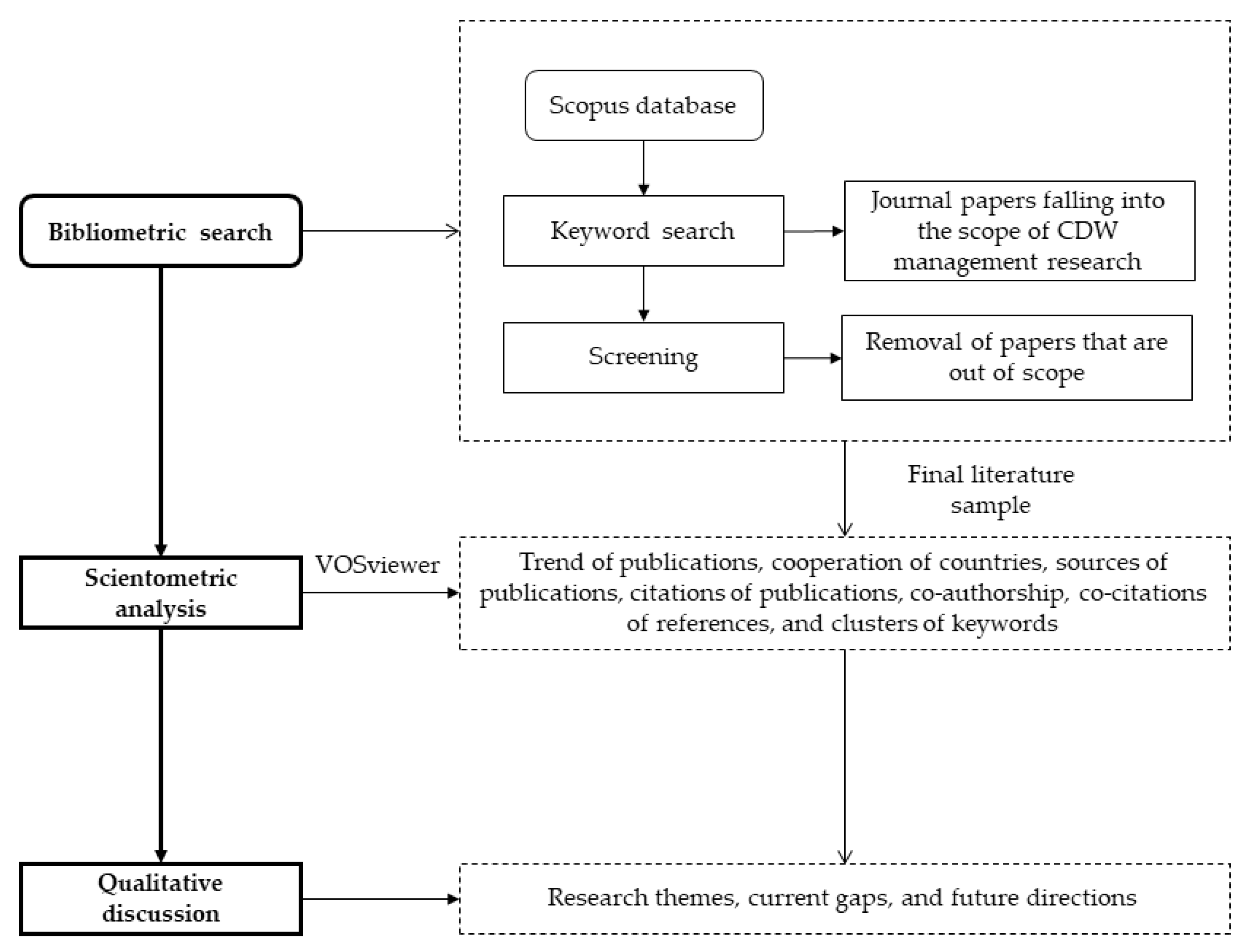
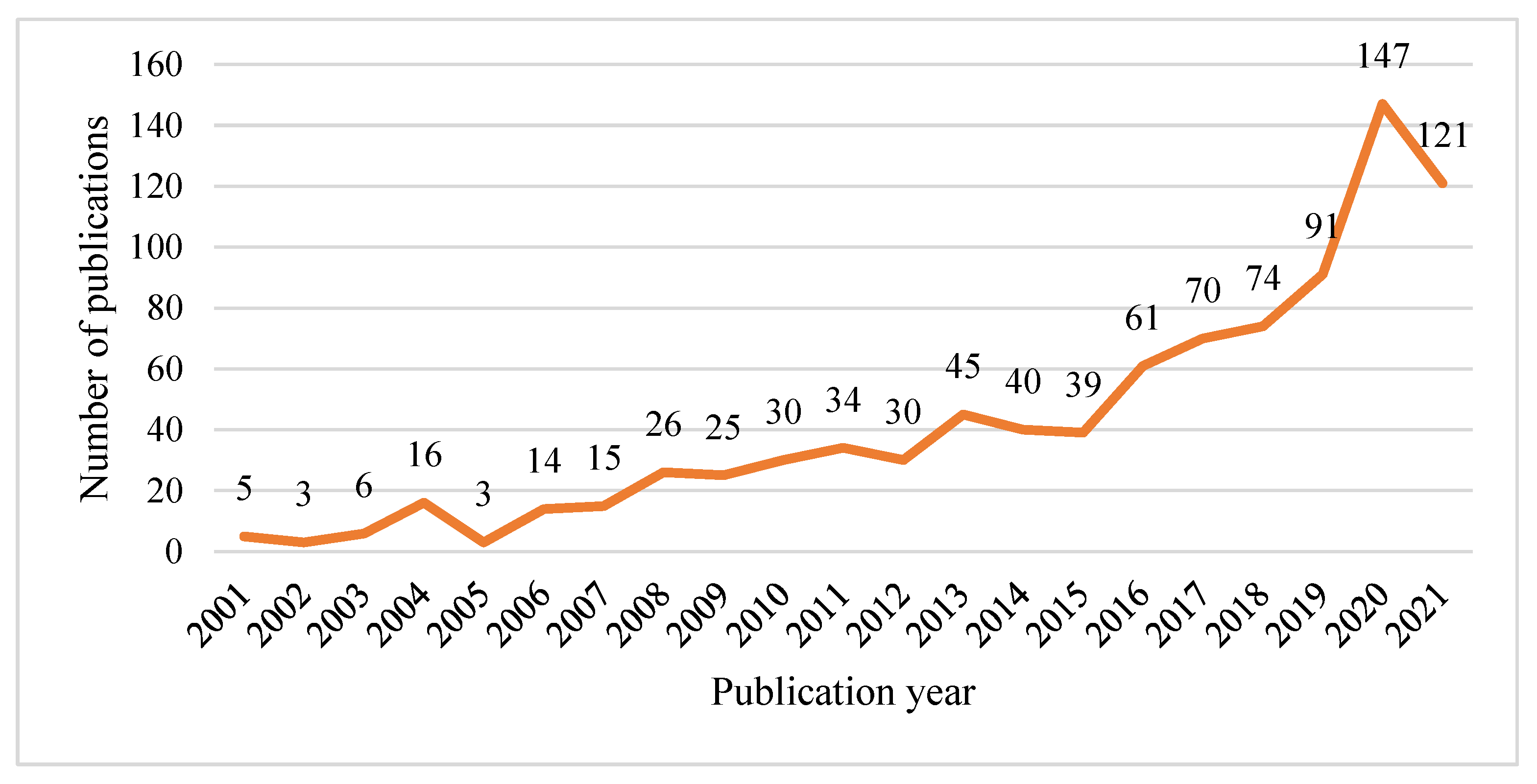
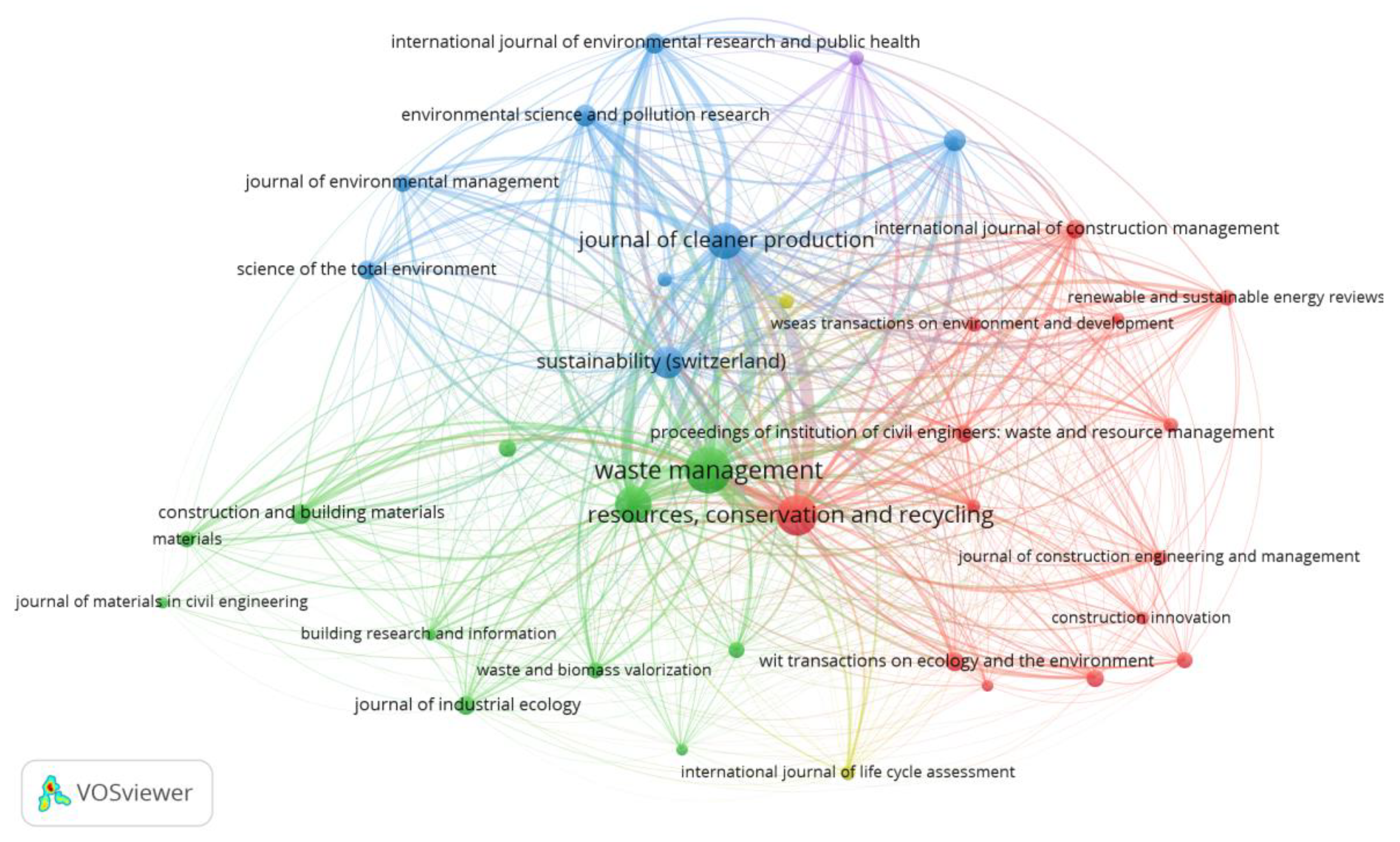
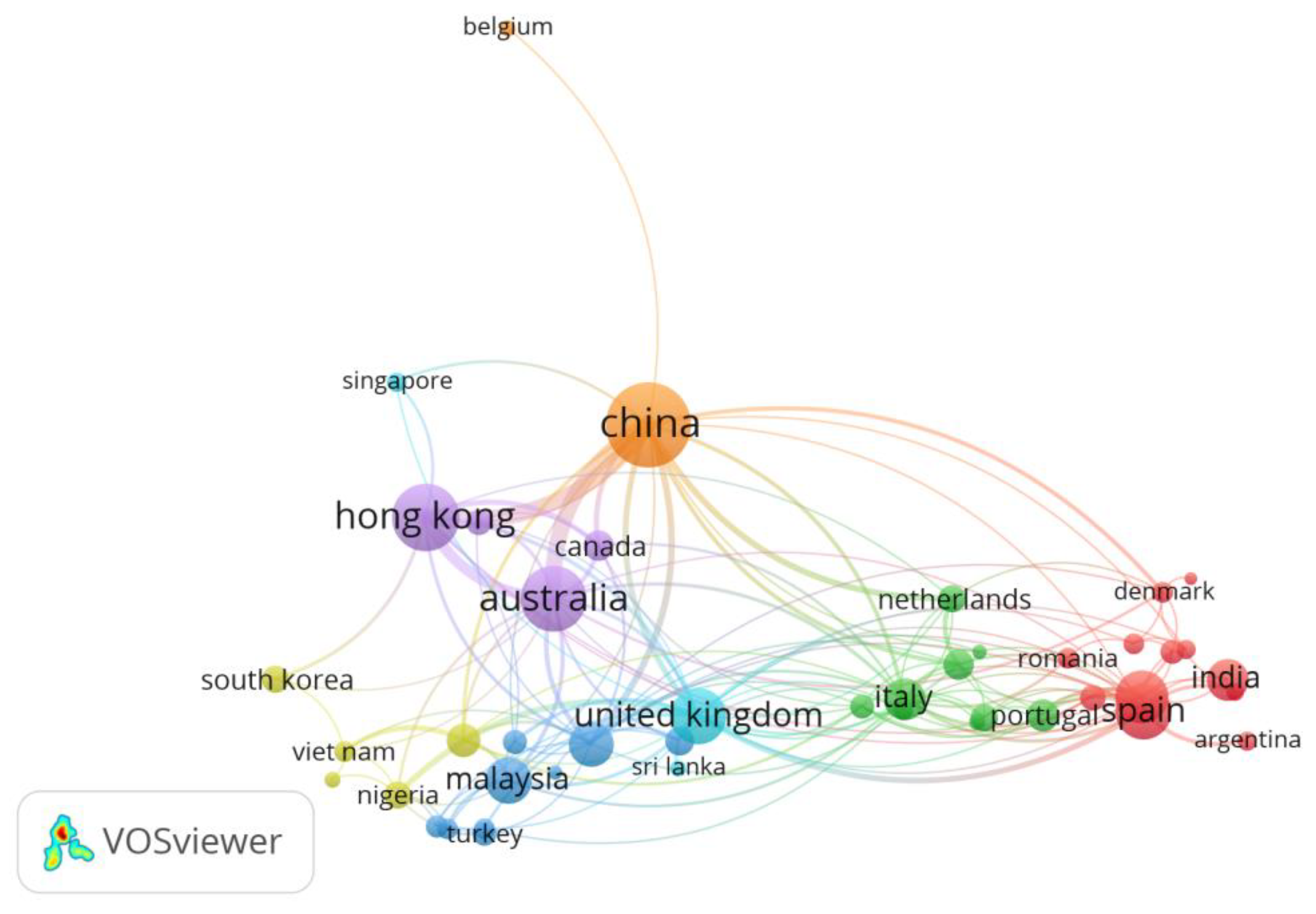
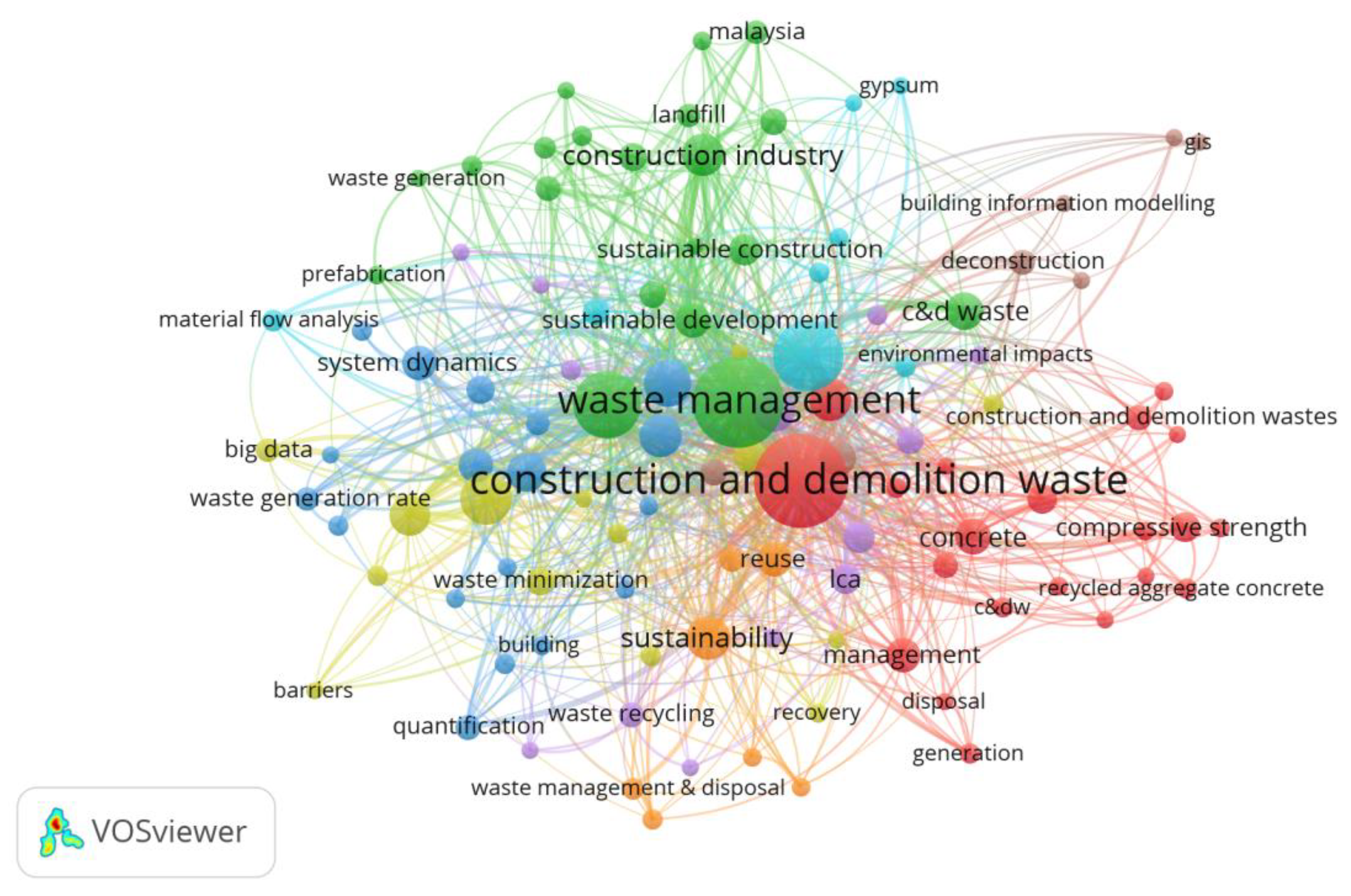
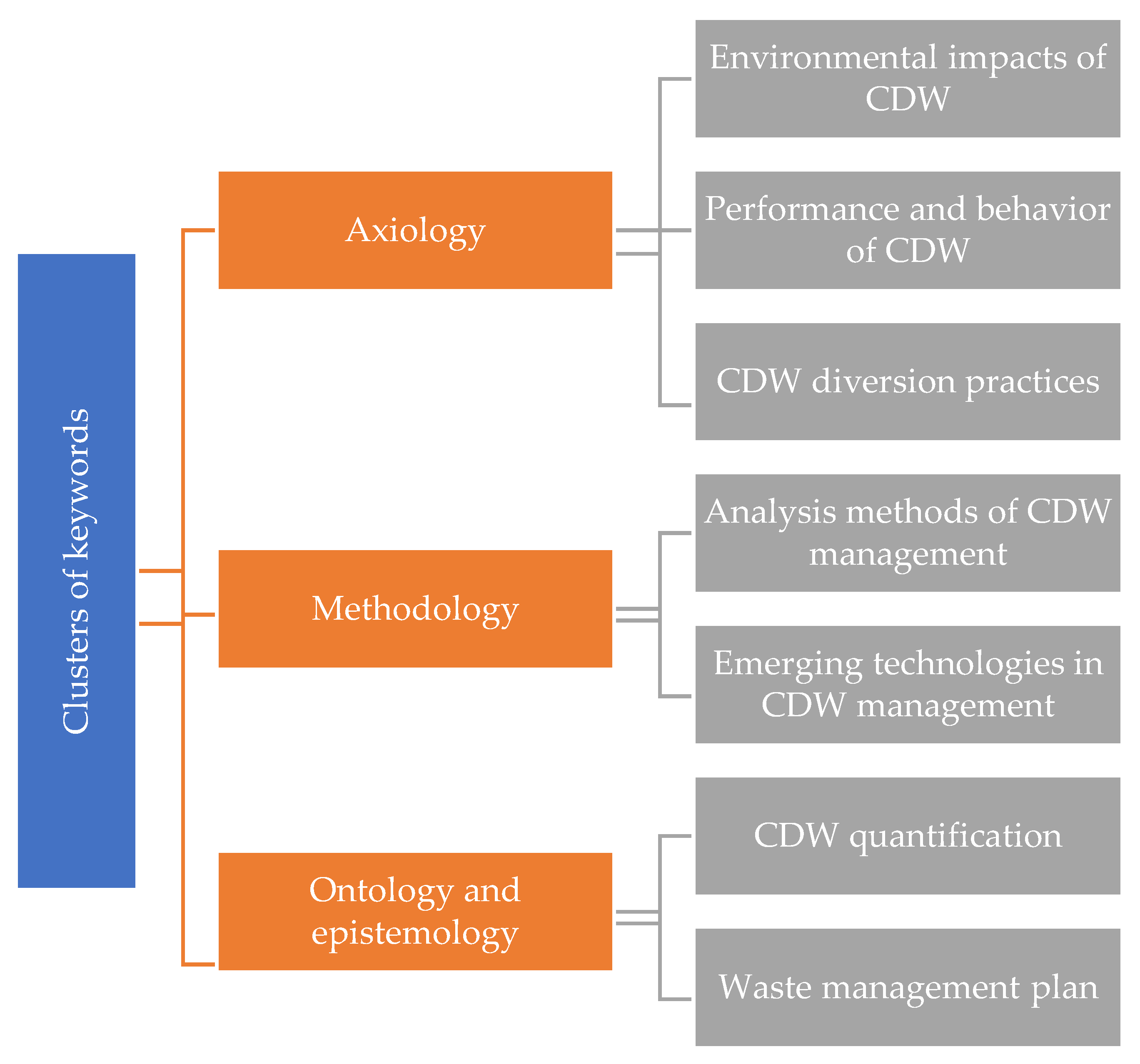
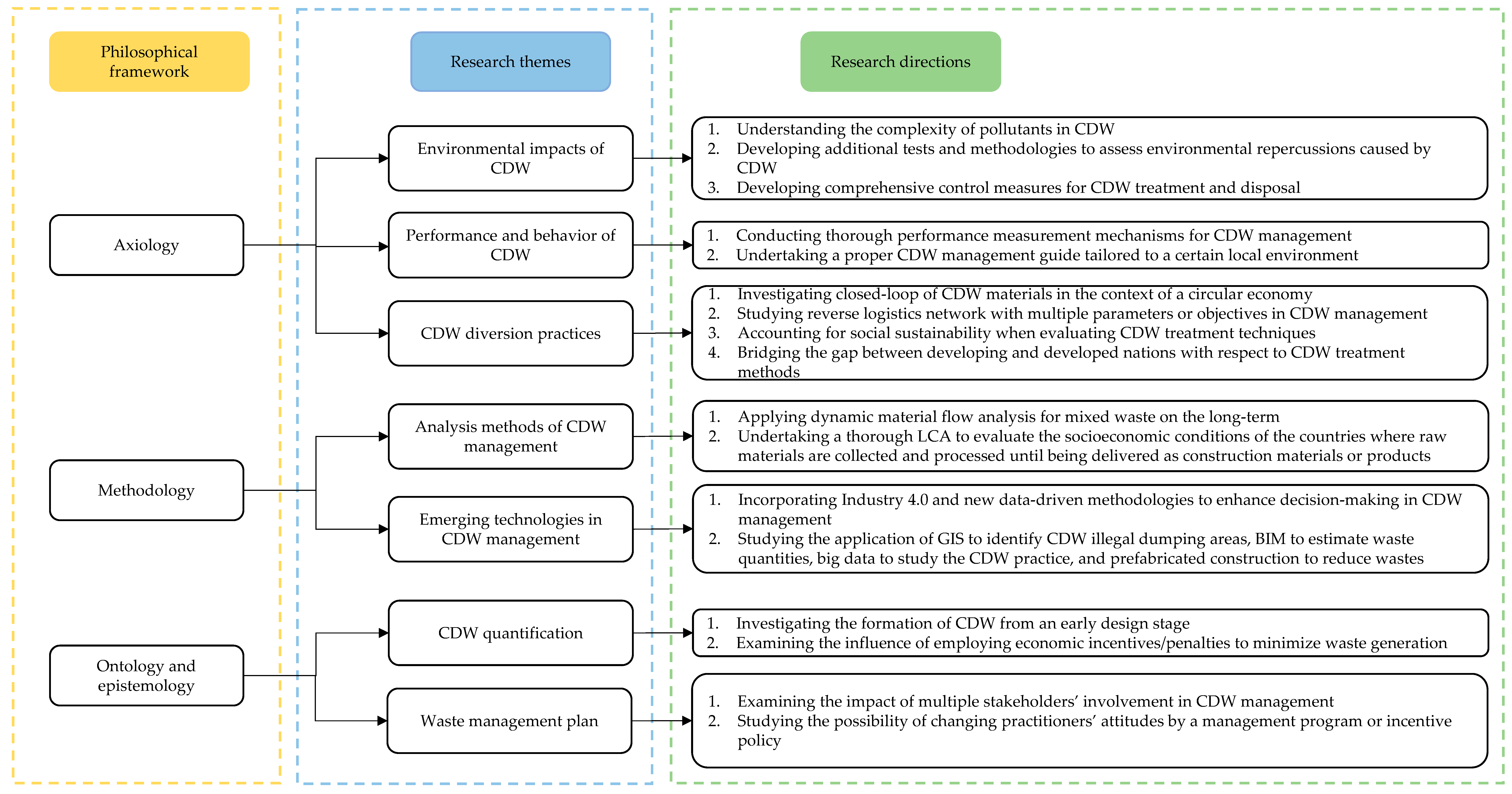
| Journal | Number of Publications | Average Publication Year | Total Citations | Average Citations | Average Normal Citations |
|---|---|---|---|---|---|
| Journal of cleaner production | 71 | 2018.24 | 3133 | 44.13 | 2.2 |
| Materials | 7 | 2019.86 | 120 | 17.14 | 1.84 |
| Resources, conservation and recycling | 95 | 2014.04 | 7354 | 77.41 | 1.84 |
| Construction and building materials | 14 | 2016.36 | 845 | 60.36 | 1.81 |
| Building and environment | 8 | 2009.88 | 723 | 90.38 | 1.48 |
| Waste management | 129 | 2015.22 | 7522 | 58.31 | 1.48 |
| Automation in construction | 4 | 2017.5 | 165 | 41.25 | 1.44 |
| Renewable and sustainable energy reviews | 7 | 2014.57 | 444 | 63.43 | 1.44 |
| Science of the total environment | 10 | 2019.3 | 213 | 21.3 | 1.4 |
| Journal of environmental management | 8 | 2019 | 143 | 17.88 | 1.34 |
| Researcher | Number of Publications | Average Citations | Average Publication Year | Total Citations | Average Normal Citations |
|---|---|---|---|---|---|
| Kabirifar K. | 6 | 21.17 | 2020.67 | 127 | 5.61 |
| Shen L. | 9 | 114.33 | 2013.33 | 1029 | 2.66 |
| Yuan H. | 29 | 76.07 | 2015.28 | 2206 | 2.2 |
| Zillante G. | 7 | 46.29 | 2018.71 | 324 | 2.18 |
| Bao Z. | 11 | 19.64 | 2020.18 | 216 | 2.02 |
| Chi B. | 6 | 20.67 | 2020 | 124 | 1.74 |
| Yu A.T.W. | 16 | 77.44 | 2014.12 | 1239 | 1.7 |
| Wu Z. | 11 | 52.27 | 2017.91 | 575 | 1.7 |
| Lu W. | 43 | 41.74 | 2017.77 | 1795 | 1.62 |
| Xue F. | 9 | 4.33 | 2020.67 | 39 | 1.11 |
| Author | Title | Journal | Publication Year | Total Citations | Normal Citations |
|---|---|---|---|---|---|
| Liu et al. [59] | An environmental assessment model of construction and demolition waste based on system dynamics: A case study in Guangzhou | Environmental Science and Pollution Research | 2020 | 97 | 8.58 |
| Huang et al. [13] | Construction and demolition waste management in China through the 3R principle | Resources Conservation and Recycling | 2018 | 245 | 7.82 |
| Gálvez-Martos et al. [60] | Construction and demolition waste best management practice in Europe | Resources Conservation and Recycling | 2018 | 219 | 6.99 |
| Ghaffar et al. [61] | Pathways to circular construction: An integrated management of construction and demolition waste for resource recovery | Journal of cleaner production | 2020 | 75 | 6.63 |
| Ruiz et al. [62] | The circular economy in the construction and demolition waste sector-a review and an integrative model approach | Journal of cleaner production | 2020 | 71 | 6.28 |
| Verian et al. [63] | Properties of recycled concrete aggregate and their influence in new concrete production | Resources Conservation and Recycling | 2018 | 191 | 6.1 |
| Marinković et al. [58] | Comparative environmental assessment of natural and recycled aggregate concrete | Waste Management | 2010 | 358 | 5.76 |
| Liu et al. [64] | Exploring factors influencing construction waste reduction: A structural equation modeling approach | Journal of cleaner production | 2020 | 64 | 5.66 |
| Osmani et al. [57] | Architects’ perspectives on construction waste reduction by design | Waste Management | 2008 | 259 | 5.59 |
| Jin et al. [29] | Science mapping approach to assisting the review of construction and demolition waste management research published between 2009 and 2018 | Resources Conservation and Recycling | 2019 | 100 | 5.58 |
| Country | Number of Publications | Average Publication Year | Number of Citations | Average Citations | Average Normal Citations |
|---|---|---|---|---|---|
| Vietnam | 9 | 2019.89 | 139 | 15.44 | 3.02 |
| Ireland | 4 | 2013.25 | 367 | 91.75 | 2.26 |
| Denmark | 8 | 2016.25 | 516 | 64.5 | 1.86 |
| Singapore | 7 | 2015 | 478 | 68.29 | 1.65 |
| Serbia | 4 | 2016.25 | 383 | 95.75 | 1.64 |
| United States | 47 | 2014.34 | 1699 | 36.15 | 1.58 |
| Hong Kong | 116 | 2014.91 | 6879 | 59.3 | 1.57 |
| Australia | 111 | 2017 | 3790 | 34.14 | 1.49 |
| United Kingdom | 75 | 2015.2 | 3451 | 46.01 | 1.4 |
| China | 189 | 2017.61 | 6624 | 35.05 | 1.36 |
| Authors | Title | Journal | Publication Year | Total Citations |
|---|---|---|---|---|
| Huang et al. [13] | Construction and demolition waste management in China through the 3R principle | Resources Conservation and Recycling | 2018 | 21 |
| Jin et al. [72] | An empirical study of perceptions towards construction and demolition waste recycling and reuse in China | Resources Conservation and Recycling | 2017 | 21 |
| Marzouk and Azab [73] | Environmental and economic impact assessment of construction and demolition waste disposal using system dynamics | Resources Conservation and Recycling | 2014 | 21 |
| Li et al. [74] | A model for estimating construction waste generation index for building project in China | Resources Conservation and Recycling | 2013 | 19 |
| Ajayi et al. [75] | Waste effectiveness of the construction industry: Understanding the impediments and requisites for improvements | Resources Conservation and Recycling | 2015 | 18 |
| Keyword | Occurrences | Average Publication Year | Average Citations | Average Normal Citations |
|---|---|---|---|---|
| Review | 6 | 2017.83 | 66.17 | 2.44 |
| Urbanization | 5 | 2018.20 | 52.00 | 2.27 |
| Resource recovery | 6 | 2013.17 | 51.17 | 2.12 |
| Waste recycling | 11 | 2017.45 | 51.45 | 1.84 |
| Environmental assessment | 6 | 2019.67 | 22.00 | 1.81 |
Publisher’s Note: MDPI stays neutral with regard to jurisdictional claims in published maps and institutional affiliations. |
© 2022 by the authors. Licensee MDPI, Basel, Switzerland. This article is an open access article distributed under the terms and conditions of the Creative Commons Attribution (CC BY) license (https://creativecommons.org/licenses/by/4.0/).
Share and Cite
Elshaboury, N.; Al-Sakkaf, A.; Mohammed Abdelkader, E.; Alfalah, G. Construction and Demolition Waste Management Research: A Science Mapping Analysis. Int. J. Environ. Res. Public Health 2022, 19, 4496. https://doi.org/10.3390/ijerph19084496
Elshaboury N, Al-Sakkaf A, Mohammed Abdelkader E, Alfalah G. Construction and Demolition Waste Management Research: A Science Mapping Analysis. International Journal of Environmental Research and Public Health. 2022; 19(8):4496. https://doi.org/10.3390/ijerph19084496
Chicago/Turabian StyleElshaboury, Nehal, Abobakr Al-Sakkaf, Eslam Mohammed Abdelkader, and Ghasan Alfalah. 2022. "Construction and Demolition Waste Management Research: A Science Mapping Analysis" International Journal of Environmental Research and Public Health 19, no. 8: 4496. https://doi.org/10.3390/ijerph19084496
APA StyleElshaboury, N., Al-Sakkaf, A., Mohammed Abdelkader, E., & Alfalah, G. (2022). Construction and Demolition Waste Management Research: A Science Mapping Analysis. International Journal of Environmental Research and Public Health, 19(8), 4496. https://doi.org/10.3390/ijerph19084496








